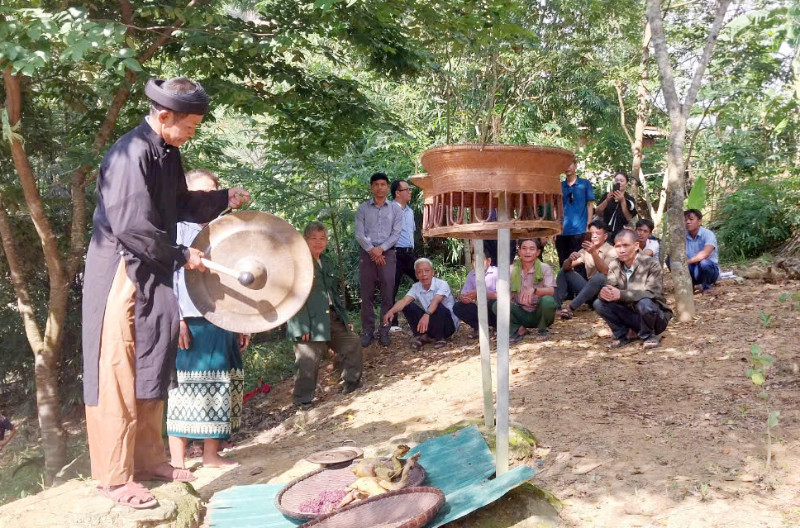The Giang Son worship ceremony of the Chut ethnic group is held to honor their ancestors and express gratitude to heaven, earth, and the forest spirits for protecting their villages. A particularly unique aspect of this ceremony is that participants must undergo a ritual cleansing before taking part.
A sacred ritual

The Chut ethnic group consists of several subgroups, including the May, Sach, Ruc, Ma Lieng, and A Rem, who live in scattered villages along the border of Minh Hoa District, Quang Binh Province.
Although they have their own language, the Chut people do not have a written script. Their customs and rituals have been passed down orally for generations. The Giang Son worship ceremony is an annual tradition. The name of the ceremony is a more recent adaptation, but its significance is similar to the peace-seeking ceremonies practiced by other ethnic groups in Vietnam.
According to village elders, the Giang Son ceremony was traditionally held twice a year. The first, known as the "opening the land" ceremony, took place at the beginning of the year (typically in the third lunar month) to pray for peace and seek blessings from local deities for fertile land and a bountiful harvest. The second, the "closing the land" ceremony, was held around the tenth lunar month as a gesture of gratitude to the spirits.
For each ceremony, neighboring villages that shared the same dialect would contribute offerings such as pigs, chickens, upland sticky rice, and banana flowers. The ceremonial tray was arranged in two tiers: the upper tier was dedicated to the land spirits, while the lower tier was for ancestors and deceased community members who continued to watch over the village.
Among the May and Sach groups, the offerings were relatively simple and varied depending on the year’s conditions. However, the most important elements of the ceremony were the location and the ritual master.
The ceremony site is a fixed sacred place, passed down through generations, always positioned facing the forest. The ritual master is a respected elder in the village, entrusted with reciting the sacred prayers that have been handed down through time.
For many years, Ho Tot has been the ritual master for the May people in Do-Ta Vong village, Trong Hoa commune.
According to Ho Tot, the prayers recited during the ceremony are of utmost importance, as each piece of land, forest, and river is believed to be inhabited by spirits. If the name of a spirit is accidentally omitted during the prayers, the villagers may experience misfortunes in the areas where the omission occurred.
These sacred prayers are only passed down to a single individual in each generation within the May community.
Ritual cleansing before attending

Even the elderly Ruc people in Thuong Hoa commune cannot recall when the Giang Son worship ceremony first began. Due to past economic hardships, the ceremony was once held only once every three years. However, in recent years, it has been conducted annually in On village.
Preparations for the ceremony begin the evening before, with villagers gathering firewood and keeping the communal fire burning throughout the night. Offerings are contributed by the community - if times are good, a pig is sacrificed; otherwise, a chicken is used for the ceremony.
According to Ruc beliefs, participants must undergo a purification ritual before taking part in the ceremony to cleanse themselves of sins and impurities. If they fail to do so, the spirits will not recognize them and will withhold their blessings.
Cao Ngoc Doan, a 58-year-old resident of On village, explained that respected members of the village go into the forest to collect seven special stones along with a bundle of jungle leaves known as Tri ang Ca panh.
“The stones are washed and heated until red-hot in the fire, then placed into pots of water infused with Tri ang Ca panh leaves. These pots are set at the entrance to the ceremony site. Once the water cools, the ceremony master sprinkles it onto each participant for purification. This is a mandatory step - anyone who does not undergo this cleansing is not allowed to join the ceremony,” Doan said.
Honoring the spirits and seeking blessings
The ceremony is led by the eldest and most knowledgeable village elders, who are deeply familiar with the geography of the local mountains, forests, and streams. The prayers, recited in the Ruc language, express gratitude to ancestors and the spirits for their protection and blessings. They also include prayers for wandering spirits who have no descendants to worship them, in hopes of preventing misfortune for the village.
In the past, the ritual master would use two short wooden blocks (each with two sides) to toss onto a jungle knife, interpreting their positions to seek approval from the spirits. Today, this practice has been replaced by the use of two coins, one representing yin and the other yang.
Once the spirits’ approval is granted, villagers gather around the communal fire to feast, sing, and celebrate, praying for a peaceful and prosperous year ahead.
Currently, the Chut ethnic community in Quang Binh comprises nearly 1,900 households with more than 7,800 people. According to Dinh Tien Dung, Vice Chairman of Minh Hoa District People's Committee, the Giang Son worship ceremony is not only a spiritual event but also a vital cultural heritage of the Chut people.
Preserving these traditions plays a crucial role in fostering the sustainable development of the community. Additionally, it holds significant potential as a cultural tourism attraction, contributing to the local economy and social development.
Hai Sam